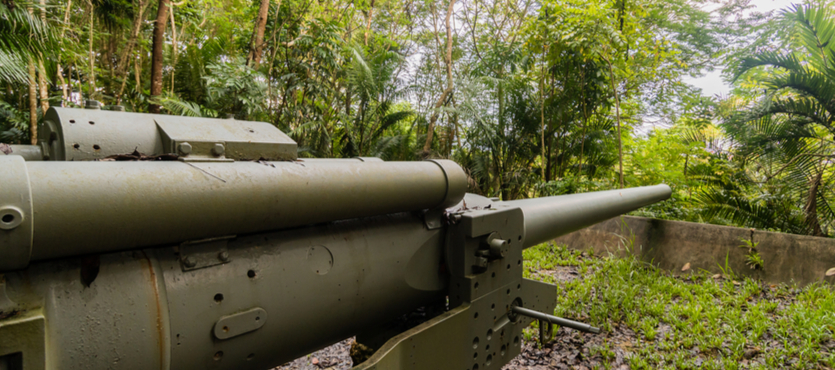As part of a wider program, the U.S. Navy has doubled the size of the submarine fleet stationed in Guam.
Submarine Commodore Bret Grabbe rather cryptically said the redeployment was necessary to “support Indo-Pacific initiatives and missions.” Not coincidentally, the move comes as China expands its fleet of five ballistic missile and 50 attack submarines.
As part of the move, Rear Adm. Jeffrey Jablon said the military was upgrading Guam’s harbor facilities. Other projects include a new base hospital as well as expanded and renovated barracks.
Layovers in Guam
For much of its history, this Pacific island has been a waystation. That is changing now in light of a possible conflict with China. More on that below.
In prehistoric times, Guam was a waystation for migration between larger island groups in the Central and South Pacific. The people who stayed behind on Guam later became the Chamorros. In Chamorran society, the wealthiest people lived on the coast, where fishing was best. The poorer people lived on the island’s interior.
After Ferdinand Magellan “discovered” Guam for the Spanish in 1521, the island became a waystation for treasure-laden galleons making the long trip from Mexico to the Philippines. The ruins of some Spanish forts built for this purpose are still visible today. Naitive Chamorrans strongly resisted Spain’s attempts to Christianize the island. A series of wars beginning around 1670, coupled with a debilitating smallpox epidemic, reduced the naitive population from more than 100,000 to less than 5,000.
As Spanish influence over the island, and interest in it, waned, Guam became a waystation and supply depot for whaling ships. An 1848 earthquake and tsunami largely put an end to these activities.
The Americans took control of Guam in 1898 and used it as a naval waystation for ships traveling between the mainland and the Philippines. During this period, the Chamorran population increased substantially. But that trend ended in World War II.
On December 8, 1941, as part of the Pearl Harbor offensive, Japan occupied Guam and held it for the next three years. The Japanese occupation was brutal. Some historians estimate that violence killed 10% of the native population. U.S. Marines recaptured the island in August 1944, after a bloody two-week battle.
Guam was also a Cold War waystation for conflicts in Korea and Vietnam. The U.S. military presence grew in the early 1990s, when large American bases in the Philippines closed and many of the assets were relocated to Guam. Military downsizing in the mid and late 1990s hit the island’s economy hard.
Guam and China and Private Military Contractors
In 2011, American B-2 bombers flew sorties over Libya from bases in Missouri. The DoD believes that air crews and aircraft can duplicate that distance flying feat if war breaks out between the United States and China. So, the military downsizing days on Guam are over. The island is now the center of a large military buildup, and contractors are an important part of this buildup.
Military Support
Admittedly, there is not a whole lot of military support necessary on a remote island like Guam that is far from the line of fire. But contractors still serve in this area.
Base security is one example. As mentioned, Guam is a pretty quiet outpost. That solitude and isolation is not always a good thing. Servicemembers who are far from home often get restless at places like Guam. They do not mean to start trouble, but sometimes, that is what happens. Contractors often draw MP duty on weekend nights when no one else wants it.
Additionally, no one knows when relations with China might go sideways. When that happens, it will probably happen pretty quickly. All military equipment, including sophisticated drones and missiles, needs to be ready to go at a moment’s notice. Contractors provide that kind of attentive maintenance. Many contractors have insider knowledge since they worked at the defense contractors who built the machines.
Construction Activities
Advanced aircraft and ships need a place to call home. So do the men and women who serve. In both cases, bare minimum facilities will not do. Only the most sophisticated airstrips, hangers, and docks can house the most sophisticated airplanes and ships. Additionally, barracks and other such facilities need to be on the cutting edge, in order to keep morale high.
Contractors usually supervise these construction activities. Contractors are the bridge between remote project managers and the workers who swing hammers.
Construction work in Guam is not just vital. It is also dangerous. Common construction injuries include:
- Falls,
- Electrocutions,
- Caught-between injuries, and
- Struck-by injuries.
Back home, these four injuries account for most of the fatal construction accidents in the United States.
Civilian Relations
There is a reason we mentioned that bit of trivia about the structure of Chamorran society. Interior residents naturally resent coastal residents. That is especially true when the coastal residents are part of an occupying army.
The U.S. has occupied Guam for more than a hundred years and the natives have never revolted. So, there is not much ill will toward Americans among Guamanians. But let’s face it. If people have a choice between blazing their own path and following someone else’s orders, they will almost always choose door number one.
Private military contractors who serve as MPs stop trouble before it starts. Contractors serve in basically the same capacity when it comes to civilian relations. As mentioned, people have lived on Guam for a very long time. Frequently, construction projects unearth ancient relics. When that happens, it is a lot easier to smooth things over if the construction workers were private contractors as opposed to regular military.
If you or a loved one was injured on Guam as a contractor, contact Barnett, Lerner, Karsen, Frankel & Castro, P.A.

